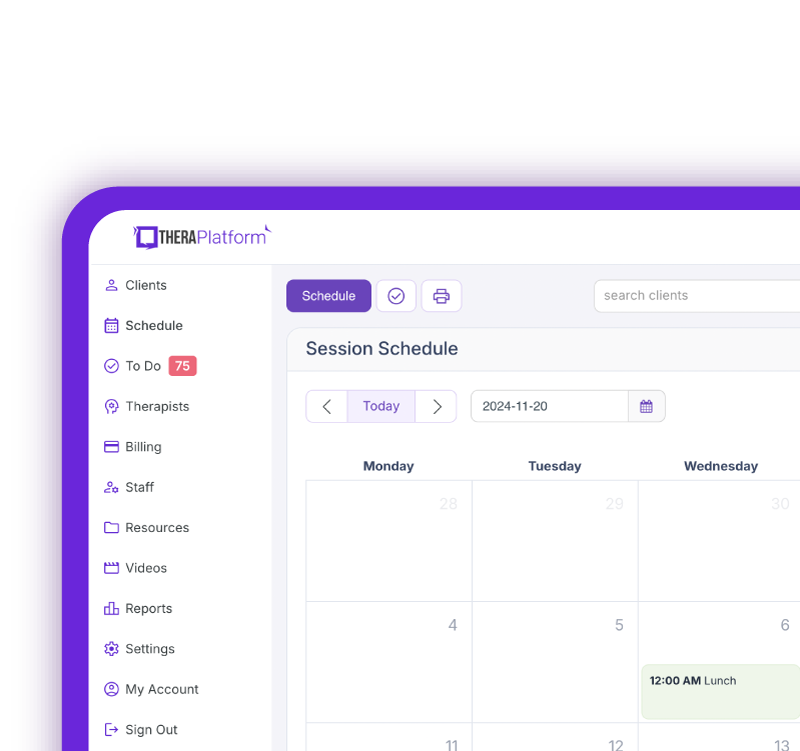Modifier 52

Modifier 52 is used by therapists in billing when they do not deliver a planned service. Unexpected circumstances can arise, and Modifier 52 is used to indicate that a therapist partially reduced or eliminated a service or procedure at the therapist's discretion.
Summary
- Modifier 52 is used by therapists to indicate that a service or procedure was reduced or eliminated due to the therapist’s discretion, ensuring accurate billing when full services are not provided but remain clinically appropriate.
- It is appropriate for use in situations where a session is shortened or partially completed due to client limitations, illness, fatigue, or client requests, as long as the reduction is at the therapist's discretion.
- Therapists must provide thorough documentation, including the reason for reduced services and specific client responses, to ensure transparency and support billing claims when using Modifier 52. Enrolling in an insurance billing course for therapists can help providers enhance their knowledge.
- Proper use of Modifier 52 ensures ethical billing practices, reduces errors, and helps therapists receive appropriate reimbursement while maintaining compliance with payer policies. Leveraging an EHR like TheraPlatform for efficient documentation and claim submission, can help therapists improve compliance with HIPAA and payer guidelines, ensure timely reimbursement, and enhance overall billing accuracy for telehealth services.
→ Click here to enroll in our free on-demand Insurance Billing for Therapists video course [Enroll Now]
In this case, the full procedure or service described by the CPT code (Current Procedural Terminology) was not provided. However, the therapist completed a clinically appropriate portion.
Modifier 52 ensures accurate billing when full service is not provided but remains clinically appropriate. Therapists can use the modifier to accurately reflect the services provided, leading to proper reimbursement and helping prevent possible billing errors.
Using Modifier 52 when appropriate helps therapists maintain transparency in service delivery and uphold a standard of ethical billing.
Streamline your insurance billing with One EHR
- Claim batching
- Auto claims
- Automated EOB & ERA
- Real-time claim validation
- Real-time claim tracking
- Aging and other reports

When to use Modifier 52
Modifier 52 is intended for use in cases where a specific service is intentionally reduced or eliminated by the therapist. It does not apply to situations in which circumstances beyond the therapist's control cause the reduction of a service.
Applicable scenarios include:
- Shortened therapy sessions due to client limitations or interruptions. The therapist may end a session earlier than scheduled due to a client experiencing a medical issue or becoming fatigued.
- Partially completed evaluations or treatments. Modifier 52 may be used when an evaluation or treatment session is not fully completed at the therapist's discretion due to a client's condition.
- A client requests to end the session early. If the client chooses to end a session early (for example, due to a schedule conflict) and the therapist deems that the completed portion of the service is clinically valuable, Modifier 52 may be used.
Watch this video to learn common insurance billing struggles and solutions
→ Start My Free Trial
→ Start My Free Trial
Examples of Modifier 52 use:
- A 60-minute therapy session is planned. However, the client becomes fatigued after 30 minutes and cannot continue participating. The therapist determines it is clinically appropriate to provide interventions during the shortened time frame and end the session early.
- The client is scheduled for a comprehensive, 2-hour speech therapy evaluation but begins feeling ill after 60 minutes. The therapist cannot present all components of the evaluation and ends the evaluation early. The therapist documents the portions of the evaluation that were completed.
- A client is scheduled for a 45-minute session but has a family emergency that arises after 30 minutes and asks to end the session.
Documentation requirements using Modifier 52
Therapists must provide accurate and detailed documentation when using Modifier 52 and include the following components.
Reason for reduced service using Modifier 52
The therapist should clearly explain in detail why the service was reduced when using Modifier 52. This includes:
- Specification of the service that was initially scheduled.
- A description of the portion of the service that was completed.
- A clear statement of the reason the therapist reduced the service. For example, it interferes with client behaviors, fatigue, or other circumstances.
Client notes for Modifier 52
Documentation in client notes should be thorough and clear to reflect consistency among documentation in case of a potential audit.
Notes should include:
- Specific details about the client's condition during the session.
- A description of the client's response to therapy.
- The challenges or limitations observed led to discontinuing the session or evaluation earlier than scheduled.
- Details regarding the therapist's clinical judgment and why continuing the service was inappropriate.
Billing guidelines using Modifier 52
- Placement: Modifier 52 should be attached to the relevant CPT code when billing. This reflects that the service was partially completed.
- Payer-specific rules: Therapists should confirm payer policies, as not all insurers may recognize or reimburse services with Modifier 52. Specific guidelines should be checked for Medicare, Medicaid, and private insurers.
The therapist's documentation should align with the specific payer requirements to reduce the risk of a claim denial. Remember that payer policies can change over time, and it's essential to participate in continuous education.
- Fee adjustment: Therapists can expect a reduced reimbursement proportional to the service provided. Reviewing payer fee schedules can provide a clear understanding of how reimbursement is calculated. Billing staff within a therapy practice should be aware of these potential reductions when Modifier 52 is used to support the practice's financial stability.
Practice Management + EHR + Telehealth
Mange more in less time in your practice with TheraPlatform

Best practices for using Modifier 52
To ensure billing is completed accurately and ethically, therapists should adhere to recommended best practices surrounding Modifier 52.
This includes the following:
Accurate use of Modifier 52
- Avoid overuse of Modifier 52. Modifier 52 should only be used when a service is eliminated or partially reduced due to the therapist's decision.
- Do not apply Modifier 52 to services that were fully completed.
Communicating with payers on Modifier 52
- Ensure clarity on when to use Modifier 52 and how it impacts reimbursement.
- Contact payers proactively to clarify their specific procedures and policies.
- All documentation with payers should be documented.
Train staff on Modifier 52
- Educate billing staff to handle partial service claims correctly.
- Provide ongoing training and education on billing modifiers such as Modifier 52.
Therapists can ensure they follow ethical, appropriate billing practices by using Modifier 52 accurately, communicating with payers, and training staff.
Modifier 52 plays an important role in ethical billing by ensuring that claims accurately reflect the services provided. Therapists can use Modifier 52 when appropriate to help prevent overbilling and ensure that the appropriate compensation is provided for the therapist's work.
Therapists have an essential role in the billing process. They are responsible for ensuring the proper use of modifiers such as Modifier 52 to maintain compliance and transparency.
Therapists must maintain thorough documentation to support reduced services when using Modifier 52. Of course, it is essential to stay educated on payer policies and regulations and ensure compliance.
Therapists can utilize TheraPlatform for more helpful resources. Providers can use TheraPlatform to manage several aspects of their services, from documentation to financial organization and scheduling. Consider starting with a free trial of TheraPlatform today.
How EHR and practice management software can save you time with insurance billing for therapists
EHRs with integrated billing software and clearing houses, such as TheraPlatform, offer therapists significant advantages in creating an efficient insurance billing process. The key is minimizing the amount of time dedicated to developing, sending, and tracking medical claims through features such as automation and batching.
What are automation and batching?
- Automation refers to setting up software to perform tasks with limited human interaction.
- Batching or performing administrative tasks in blocks of time at once allows you to perform a task from a single entry point with less clicking.
Which billing and medical claim tasks can be automated and batched through billing software?
- Invoices: Create multiple invoices for multiple clients with a click or two of a button or set up auto-invoice creation, and the software will automatically create invoices for you at the preferred time. You can even have the system automatically send invoices to your clients.
- Credit card processing: Charge multiple clients with a click of a button or set up auto credit card billing, and the billing software will automatically charge the card (easier than swiping!)
- Email payment reminders: Never manually send another reminder email for payment again, or skip this altogether by enabling auto credit card charges.
- Automated claim creation and submission: Batch multiple claims with one button click or turn auto claim creation and submission on.
- Live claim validation: The system reviews each claim to catch any human errors before submission, saving you time and reducing rejected claims.
- Automated payment posting: Streamline posting procedures for paid medical claims with ERA. When insurance offers ERA, all their payments will post automatically on TheraPlatform's EHR.
- Tracking: Track payment and profits, including aging invoices, overdue invoices, transactions, billed services, service providers.
Utilizing billing software integrated with an EHR and practice management software can make storing and sharing billing and insurance easy and save providers time when it comes to insurance billing for therapists.
Streamline your practice with One EHR
- Scheduling
- Flexible notes
- Template library
- Billing & payments
- Insurance claims
- Client portal
- Telehealth
- E-fax

Resources
TheraPlatform is an all-in-one EHR, practice management, and teletherapy software built for therapists to help them save time on admin tasks. It offers a 30-day risk-free trial with no credit card required and supports mental and behavioral health, SLPs, OTs, and PTs in group and solo practices.
More resources
- Therapy resources and worksheets
- Therapy private practice courses
- Ultimate teletherapy ebook
- The Ultimate Insurance Billing Guide for Therapists
- The Ultimate Guide to Starting a Private Therapy Practice
- Mental health credentialing
- Insurance billing 101
- Practice management tools
- Behavioral Health tools
Free video classes
- Free on-demand insurance billing for therapist course
- Free mini video lessons to enhance your private practice
- 9 Admin tasks to automate in your private practice
References
Burks, K., Shields, J., Evans, J., Plumley, J., Gerlach, J., & Flesher, S. (2022). A systematic review of outpatient billing practices. SAGE Open Medicine, 10, 20503121221099021. DOI: https://doi.org/10.1177/20503121221099021
Romans, B., Nguyen, E., Biddle, M., Paul, A., Rosko, Z., Minaei, A., ... & Robinson, R. F. (2022). Billing and coding: disparities in healthcare provider training. Journal of Allied Health, 51(1), 43-46. DOI: https://www.ingentaconnect.com/content/asahp/jah/2022/00000051/00000001/art00009
Warren, S., & Sampson, M. (2023). Amid Billing Error Concerns, Medicare to Review SNF Claims Nationwide—and Recoup Losses. Leader Live. DOI: https://leader.pubs.asha.org/do/10.1044/2023-0515-slp-snf-claims-review/full
FAQs about Modifier 52
What is Modifier 52?
Modifier 52 indicates that a planned service was partially reduced or not fully completed at the therapist’s discretion, while still being clinically appropriate.
When should therapists use Modifier 52?
It’s used when sessions are shortened due to client fatigue, illness, or early termination by request—never when outside factors fully prevent the service.
What documentation is required with Modifier 52?
Therapists must record the reason for reduction, what portion was completed, and the client’s response to support accurate, compliant billing

